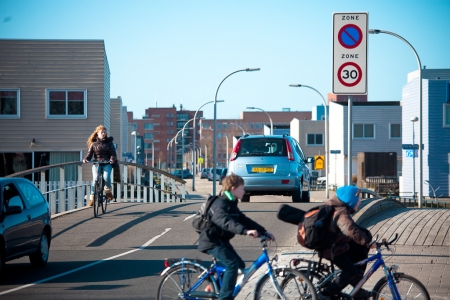At a maximum speed of 30 km/h the risk of a fatal crash is very small and it would therefore be possible to mix motor vehicles and slow traffic safely (see also the question Why a 30 km/h limit?).However, every year there are about 30 road deaths in 30 km/h zones and, according to the police registration, 500 to 600 serious road injuries [i] (see also the question What is the number of casualties on 30 km/h roads?). A logical explanation is that motorized traffic often drives (significantly) faster than the limit on 30 km/h roads (see the question What are the actual speeds driven on 30 km/h roads?). Measures to make 30 km/h zones (even) safer, will therefore need to focus especially on reducing the driving speed. Research [23] has shown that on roads in urban areas a speed reduction of about 10% will lead to (approximate and on average) 20% fewer serious road injuries and 30% fewer road deaths per year (see also SWOV Fact sheet Speed and speed management).
Furthermore, some more general infrastructural measures can be taken, in the first place aimed at predictability, crossing facilities and priority situations.
The following is an overview of (speed) measures that can make 30 km/h zones (even) safer.
Physical speed reduction measures and a credible speed limit
Many of the 30 km/h zones and roads have a ‘sober’ (not optimally safe) layout and have insufficient physical speed inhibitors (humps, chicanes, road narrowings, plateaus). Especially on the straight road stretches these are often missing. More of such speed inhibitors contribute to reduction of the driving speed. Also making the 30 km/h limit more credible can make a contribution, e.g. narrowing of roads, offering one lane for both directions, avoiding long straight road stretches and the use of brick pavement instead of asphalt. SWOV has previously calculated that if all 30 km/h roads would have a credible limit, this would annually prevent about 200 serious road injuries, especially among cyclists [7].
Police enforcement
Police enforcement is also a proven method to combat speeding (see SWOV Fact sheet Speed and speed management). For an optimum effect, the subjective probability of apprehension must be sufficiently large, for example by making controls visible, regular repeats, and accompanying enforcement with (neighbourhood) targeted communication and information (see also SWOV Fact sheet Police enforcement in traffic). The police however, indicate not being very much inclined to enforce speeds in 30 km/hour zones with a sober layout[ii].
(Area-restricted) ISA
A very effective speed measure is the Intelligent Speed Assistant (ISA) that makes physically impossible for a vehicle to exceed the limit of 30 km/h (see the archived SWOV Fact sheet Intelligent Speed Assistance (ISA)). This can be a general ISA or an ISA which functions in 30 km/h zones only. The basic technique is there, but there are still various (political, social and legal) barriers which stand in the way of large-scale implementation in the short term [24].
Neighbourhood approach
Often it proves to be the local residents who see a problem in the (very) high speeds in their neighbourhood and ask for measures to be taken. To meet this request, the Dutch Traffic Safety Association (VVN) has developed a method for a neighbourhood approach with the Neighbourhood Label Safe Traffic: https://vvn.nl/wat-we-doen/met-bewonersgroepen/buurtlabel-veilig-verkeer. In 2016, more than 670 neighbourhood activities were carried out and more than 80 working groups were active [25]. The types of activities varied greatly, for example sticking of 30 km/h stickers on dirt containers, a stopping distance demonstration, or asking children to design traffic signs. The effect of such actions is not yet known.
Predictability, crossing facilities and priority intersections
To prevent crashes caused by children crossing incorrectly (see the question How do crashes in 30 km/h zones occur?), Berends en Stipdonk [7] advise making major walking/play routes of children more noticeable: no parked cars or bushes near these routes. If there are many parked cars, sufficient crossing facilities must be present. To prevent bicycle crashes due to priority errors, Berends & Stipdonk advise improving safety at priority intersections, including separate priority cycle paths, or to replace them with intersections without any designated priorities.
